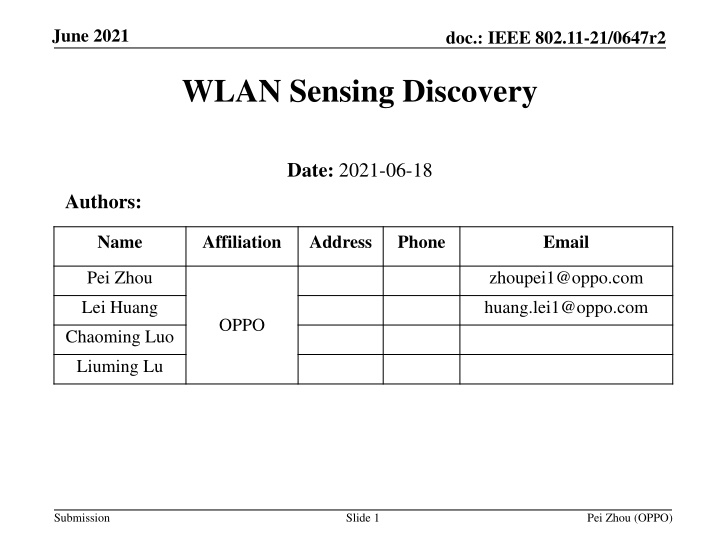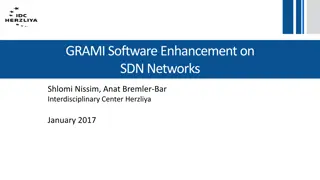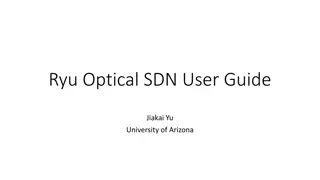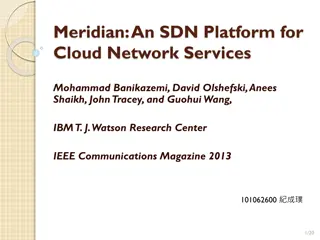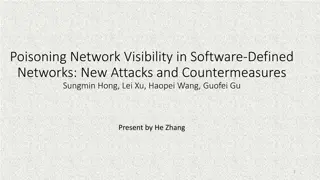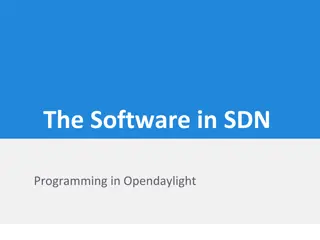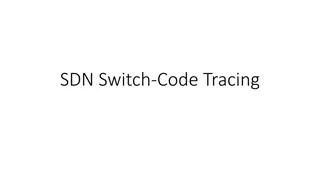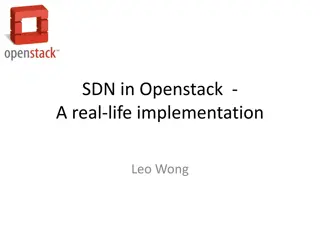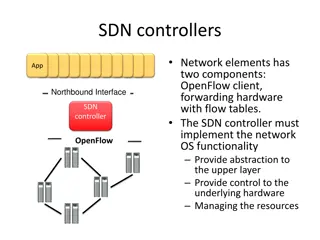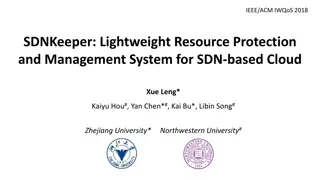Hands-on Workshop on VPLS in SDN
This workshop on Virtual Private LAN Service (VPLS) in Software-defined Networking (SDN) covers the fundamentals and implementation of VPLS, including architecture, needs, and configurations. Explore how VPLS emulates a LAN over a WAN, enabling multi-point broadcast circuits for Layer 2 connectivity. Learn about VPLS in SDN, its application in ONOS, and the conditions for establishing VPLS connectivity between end-hosts. Dive into configuring VPLS in a hands-on lab session for practical experience.
Download Presentation

Please find below an Image/Link to download the presentation.
The content on the website is provided AS IS for your information and personal use only. It may not be sold, licensed, or shared on other websites without obtaining consent from the author.If you encounter any issues during the download, it is possible that the publisher has removed the file from their server.
You are allowed to download the files provided on this website for personal or commercial use, subject to the condition that they are used lawfully. All files are the property of their respective owners.
The content on the website is provided AS IS for your information and personal use only. It may not be sold, licensed, or shared on other websites without obtaining consent from the author.
E N D
Presentation Transcript
June 2021 doc.: IEEE 802.11-21/0647r2 WLAN Sensing Discovery Date: 2021-06-18 Authors: Name Affiliation Address Phone Email Pei Zhou zhoupei1@oppo.com Lei Huang huang.lei1@oppo.com OPPO Chaoming Luo Liuming Lu Submission Slide 1 Pei Zhou (OPPO)
June 2021 doc.: IEEE 802.11-21/0647r2 Background Discovery phase should be done before sensing session. [1] In discovery phase, sensing capabilities (supported sensing roles, supported sensing measurement types, etc.) should be exchanged between sensing initiator and sensing responder(s). [1][2] In this contribution, we show how to indicate sensing capabilities for a STA. Submission Slide 2 Pei Zhou (OPPO)
June 2021 doc.: IEEE 802.11-21/0647r2 Possible Sensing Capabilities The following possible sensing capabilities may be advertised during discovery: Supported sensing roles [3]: Sensing Initiator Sensing Responder Sensing Transmitter Sensing Receiver Supported sensing bands [4]: 2.4 GHz 5 GHz 6 GHz 60 GHz Supported sensing measurement result types [3]: More than one type of sensing measurement results may be defined (Motion 12). CSI-based sensing [3] e.g., for sub-7 GHz and 60 GHz: CSI matrix [5] Radar-based sensing [3] e.g., for 60 GHz: beam SNR [6] Other capabilities So far, we need more than 10 bits to indicate the above sensing capabilities of a STA. We believe that in the process of standardization, more sensing capabilities will need to be indicated. Submission Slide 3 Pei Zhou (OPPO)
June 2021 doc.: IEEE 802.11-21/0647r2 Container of Sensing Capabilities Option 1: Add all the sensing capabilities (e.g., possible sensing capabilities shown in slide 3) into the existing frame/element (e.g., Extended Capabilities element). CSI-based sensing Radar-based sensing 2.4 GHz support 5 GHz support 6 GHz support 60 GHz support Sensing Initiator Sensing Respinder Sensing Transmitter Sensing Receiver 1 1 Bits: 1 1 1 1 1 1 1 1 Sensing measurement result types support Sensing bands support Sensing roles support Note: The sensing capabilities are TBD. Submission Slide 4 Pei Zhou (OPPO)
June 2021 Container of Sensing Capabilities (Cont.) doc.: IEEE 802.11-21/0647r2 Option 2: Design a new Sensing Capabilities element to carry all the sensing capabilities. Element ID Length Sensing Capabilities Octets: 1 1 TBD Sensing Capabilities element format Sensing types support Sensing bands support Sensing roles support Octets: 1 1 1 CSI-based sensing Radar-based sensing 2.4 GHz support 5 GHz support 6 GHz support 60 GHz support Reserved Reserved 6 Bits: 1 1 Bits: 1 1 1 1 4 Sensing measurement result types support field Sensing band support field Sensing Initiator Sensing Respinder Sensing Transmitter Sensing Receiver Reserved Bits: 1 1 1 1 4 Sensing roles support field Note: The format of Sensing capabilities element is TBD. Submission Slide 5 Pei Zhou (OPPO)
June 2021 Container of Sensing Capabilities (Cont.) doc.: IEEE 802.11-21/0647r2 Option 3: Add one bit Sensing Support signaling into the Extended Capabilities element for sensing capability indication and design a Sensing Capabilities element to carry the detailed sensing capabilities of a STA. Note: Detailed sensing capabilities may be exchanged when a sensing session is initiated (e.g., during setup phase). Sensing Support 1 Bits: Submission Slide 6 Pei Zhou (OPPO)
June 2021 doc.: IEEE 802.11-21/0647r2 Option 1 vs. Option 2 vs. Option 3 Pros. Cons. Option 1 Only >10 bits sensing capabilities are needed Overhead will be large if a STA only want to participate in WLAN sensing Option 2 The presence of Sensing Capabilities element indicates the ability for WLAN sensing; Overhead will be small if a STA only want to participate in WLAN sensing 2 additional octets are needed to indicate Element ID field and Length field Option 3 Detailed sensing capabilities can be exchanged when a sensing session is initiated One more bit is need as compared with Option 2 As described in the 802.11 spec (Clause 9.4.2.26): The Extended Capabilities element carries information about the capabilities of a STA that augment the capabilities specified in the Capability Information field. If a STA does not support any of capabilities defined in the Extended Capabilities element, then the STA is not required to transmit the Extended Capabilities element. For option 1 and option 3: if a STA that only want to participate in the WLAN sensing (in other words, the STA does not support any of capabilities defined in the Extended Capabilities element), the signaling overhead will be too large*. Therefore, it is justifiable and preferred to define a Sensing Capabilities element to carry all the sensing capabilities of a STA. * At present, more than 97 bits have been defined in this element. [7] Submission Slide 7 Pei Zhou (OPPO)
June 2021 doc.: IEEE 802.11-21/0647r2 Sensing Discovery flow Sensing capabilities (element) can be carried in Beacon, Probe Request, Probe Response, (Re)Association Request, (Re)Association Response frames, etc. Passive Scanning: Sensing capabilities (element) of AP can be carried in Beacon frame. Sensing capabilities (element) of STA can be carried in (Re)Association Request frame. Active Scanning: Sensing capabilities (element) of STA can be carried in Probe Request frame. Sensing capabilities (element) of AP can be carried in Probe Response frame. or Sensing capabilities (element) of STA can be carried in (Re)Association Request frame. Sensing capabilities (element) of AP can be carried in (Re)Association Response frame. AP STA Passive Scanning Beacon Probe Request Active Scanning Probe Response (Re)Association Request (Re)Association Response Submission Slide 8 Pei Zhou (OPPO)
June 2021 doc.: IEEE 802.11-21/0647r2 Summary We discussed three kinds of sensing capabilities indication methods: 1. Use the reserved bits of existing Extended Capabilities element to indicate all the sensing capabilities 2. Design a new Sensing Capabilities element to carry all the sensing capabilities 3. Use one bit of existing Extended Capabilities element to indicate Sensing Support and design a new Sensing Capabilities element to carry all the sensing capabilities Submission Slide 9 Pei Zhou (OPPO)
June 2021 doc.: IEEE 802.11-21/0647r2 SP #1 Which option do you prefer when the 802.11bf amendment defines the container of sensing capabilities? Option 1: use the reserved bits in Extended Capabilities element to indicate all the sensing capabilities of a STA. Option 2: design a Sensing Capabilities element to carry all the sensing capabilities of a STA. Option 3: use one reserved bit in Extended Capabilities element to indicate Sensing Support and design a Sensing Capabilities element to carry the detailed sensing capabilities of a STA. Note: The format of Sensing Capabilities element and the detailed sensing capabilities are TBD. Option 1: Option 2: Option 3: Abstain: Submission Slide 10 Pei Zhou (OPPO)
June 2021 doc.: IEEE 802.11-21/0647r2 Reference 1) 2) 3) 11-20-1851-04-00bf-overview-of-wi-fi-sensing-protocol 11-21-0370-01-00bf-considerations-of-sensing-negotiation 11-21-0147-03-00bf-definitions-and-scenarios-of-the-wlan-sensing-follow- ups 11-20-1804-01-00bf-discussion-on-wlan-sensing-procedure 11-21-0357-01-00bf-discussion-of-sensing-measurement-result-types 11-21-0407-03-00bf-multi-band-wifi-fusion-for-wlan-sensing Draft P802.11az_D3.0 4) 5) 6) 7) Submission Slide 11 Pei Zhou (OPPO)
